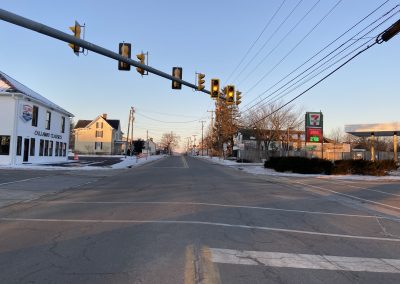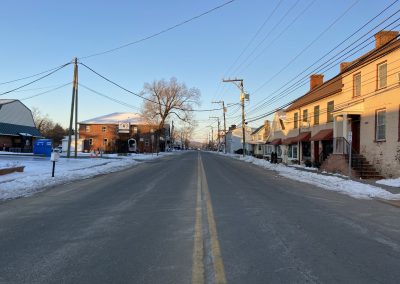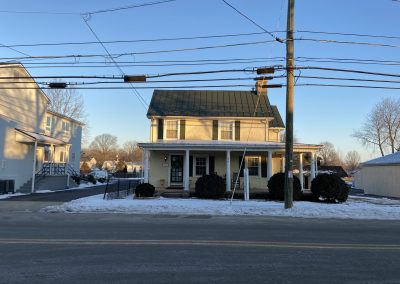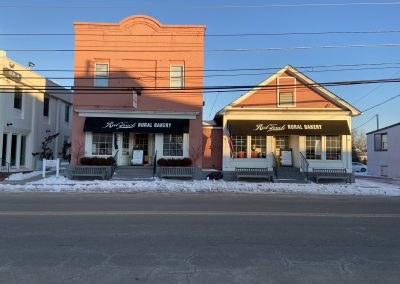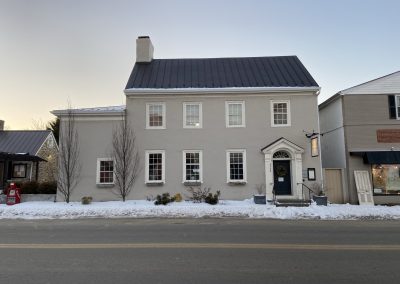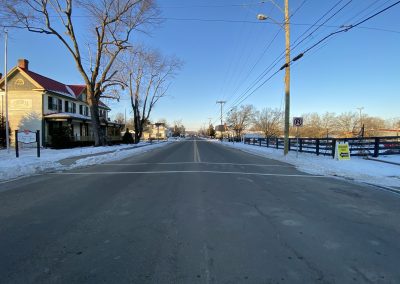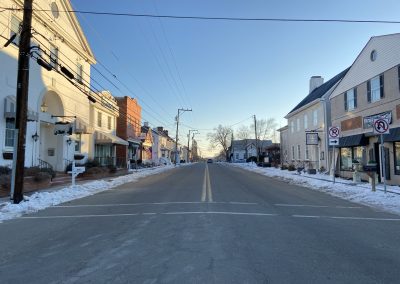Marshall Streetscape Improvements Project
General Project Overview
What is the Marshall Streetscape Improvements Project, where is it?
The Marshall Streetscape Improvements project, primarily federally funded project, is a multi-faceted infrastructure project that encompasses the area of Main Street Marshall (Route 55) just east of the intersection of Route 17 and Rectortown Road (just beyond the entrance to the BB&T bank off of Route 55) and just west of the intersection of Route 55 and Frost Street (along the front of Johnny Monarch/old IGA property). The Project includes undergrounding utility lines, improving the sidewalks, crosswalks and marked parking, new signage, as well as adding trees/plantings, and additional street lighting. In addition, storm drainage will be improve near and along Frost Street.
What is the current status of the project and approval processes?
After two bidding process between 2019 and 2020, the County Board of Supervisors awarded a construction contract to Shirley Contracting Company, LLC., as the lowest and most responsible bidder in October 2020.
Shirley is currently under their first Notice of Proceed (NTP #1) to acquire necessary permits and submission of forms required as part of the grant funding. Once permits are acquired and all forms are approved, a second Notice to Proceed (NTP #2) will be issued for construction, with an estimated start around March 1, 2021.
Substantial completion of the project is anticipated to be completed by December 31, 2021. The various utility companies may have work that extends past 2021 to complete the movement of their lines from aerial to underground. The majority of the utilities anticipate a completion within 2021.
Are there any improvements to the Marshall water system as part of the project?
The Fauquier Water and Sanitation Authority will complete some upgrades to water lines while certain portions of work are completed along Frost Street. This scope is not funded from the federal dollars, but will be completed during the project timeline to minimize impacts to the community with trenching and utility work within the roadways.
Why is the County doing this project?
Going back as far the early 1990s, a collective effort began to improve or revitalize Marshall. Residents, businesses, and county officials devoted countless hours of public service in a coordinated effort to secure grant funding for this purpose. Over time it was determined that availability of funding and projected cost to complete the plan would
require it to be broken down into phases and separate projects. The first projects were the Salem Meeting House, Winchester Road sidewalks, and the most developed business section of Main Street within this project scope. With the Marshall Main Improvement Project moving into construction, all projects within this phase are complete or under construction. The rest of Main Street, from the railroad crossing to the east and Free State Road to the west, are contemplated in the other phases which will require future funding and design.
Why are the utilities being buried underground?
As part of the vision to improve and revitalize Marshall, a portion of the Marshall Streetscape Improvement Project was also to eliminate the above-ground utilities and relocate them underground to help promote an esthetically pleasing Marshall Main Street and less weather related impacts to the utilities. The improvements to the utilities includes betterment, or expansion of the service, where now if a line is impacted it may take a day or so for service to be restored through repairs. The utility such as Dominion electric service, includes what they call redundancy where if the service is impacted they can re-route service so the downtime is lessened.
How is the project funded?
The project is primarily funded through the Virginia Department of Transportation (VDOT) Transportation Alternatives Program grant that is funded by Federal Highway Administration (FHWA). The VDOT/FHWA grants funds up to 80% of allowable costs, with a 20% local match requirement. The total allocated project budget is $6,291,265, with potential contingent costs the total cost estimate is $6,889,049, sourced through:
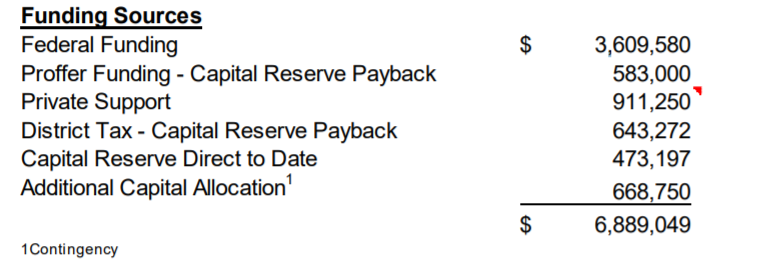
How much is the tax increase in the MELBI Levy and what will it do to my tax bill?
The tax increase is two-cents (2.0¢), or from the current half-cent (0.5¢) per $100 of assessed value to two and half-cents (2.5¢) per $100 of assessed value. This is a $20 per year tax increase per $100,000 of assessed value, from $5 to $25/year or $1.67/month.
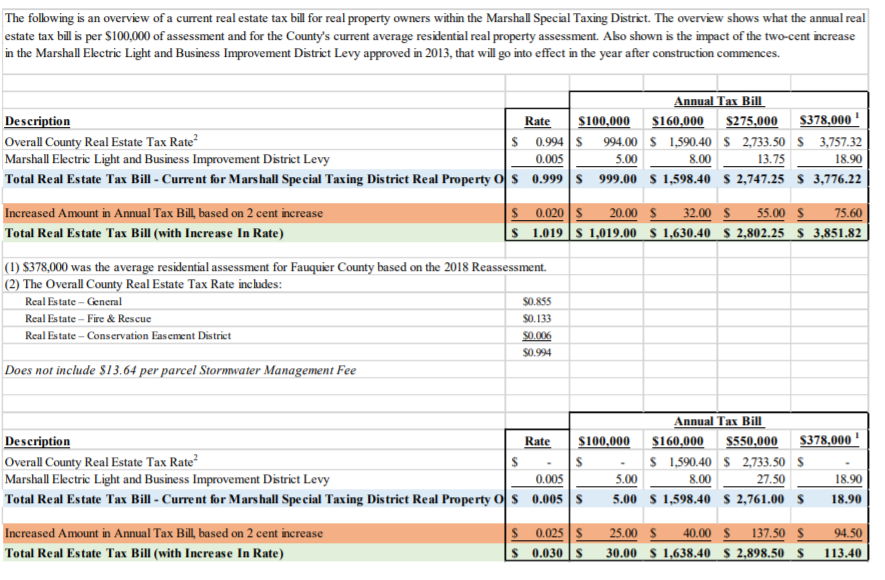
Why don’t we allow VDOT to perform basic maintenance on the sidewalks and save this money for other needs?
Prior to the project, the sidewalks were not all within the VDOT right-of-way or the VDOT maintenance system. As such, the sidewalks within Marshall are maintained by VDOT on a limited basis such as curb ramps. Upon project completion and standard acceptance processes, the sidewalks will be maintained by VDOT. There are some limited materials that VDOT does not currently maintain within the project scope. Those materials such as the crosswalks have a substantial life cycle with maintenance/replacement not required for a minimum of 10-15 years. Whether the County or VDOT will replace those materials will be addressed at that time, and in conformance with the standards at that time.
How will the impacted property owners be notified of construction timing, etc. that affects their property?
The Construction, Engineering, and Inspection (CEI) firm, in combination with the County’s Construction Project Manager, will coordinate and notify property owners of impacts, timelines, etc. throughout the project construction. Construction should not create business closures, and construction bidders are required as part of the contract to maintain access to businesses during normal working hours. In addition, the County’s project webpage will include a schedule of milestones and timelines.
How will traffic along Main Street be effected during construction?
During the project, two-way traffic will be maintained at all times. VDOT has required that the intersections of Main Street/Winchester & Rectortown Roads and then Main Street/Frost Street be the first two construction areas, with the area between the intersections being the final construction areas. There will be times that portions of the parking lane and sidewalks will be closed during active construction in sections. The sidewalks will have required detours. In addition, many of the businesses have agreed to open and announce available parking for patrons of businesses within the closed areas.
Will there be detours at all during construction?
During construction at the two intersections there will be detours to limit turning from these intersections onto Main Street. However, no traffic will be detoured onto roadways such as Salem Avenue or Anderson Avenue. The only non-local traffic detour will be for left turns onto Main Street when heading north on Route 17, near the former Marshall Ford site, turning left on to Main Street/Route 55 west. The detour will route traffic up Old Stockyard Road to turn left onto Main Street (Route 55 west). This was a requirement of VDOT, and based on VDOT traffic review as to how larger truck traffic is already traversing Main Street. Local residential traffic in the areas of Frost Street may need to re route during construction hours when work is being performed at Frost Street and Main Street.
Is the project going to cause Main Street to lose parking or is parking being removed anywhere?
The project will establish marked parking, this will improve the line of sight and accessing the many entrances along Main Street since the parking will provide adequate spacing from those entrances. There will be approximately 40 marked parking spaces, both handicap and general use.
Why is the roadway being narrowed, why do we have to make the sidewalks ADA compliant?
A requirement of any work completed within the VDOT right of way, as well as acceptance of federal funding, is to meet ADA compliance. There are various conditions of the project area that relate to how the sidewalks have to be designed to meet ADA compliance, including but not limited to widths; grades; pathway clearances, etc. There are waivers that have been approved for areas where the sidewalk width does not allow for two people to traverse the sidewalk in opposite directions, these are limited in nature.
Where is there still brick in the project?
Brick is not being used throughout the sidewalks or the primary areas for pedestrian traffic. Brick is being used to replace the two-foot grass strip between the sidewalk and the curb/gutter, parallel to the roadway and in the sidewalk/ramp areas at the intersections. At the intersections, the brick sidewalk area does extend out just past the ramp areas. The use of brick in these areas is allowable under various County, State, and Federal design standards and does not pose a safety concern or long term maintenance concern, as these areas are not impacted by vehicular traffic.
Can we include banner bars on the street lights?
Yes, bars to allow for banners, wreaths, etc. are included on the light posts and were originally planned for Main Street.
Can we exclude the landscaping components of the project including the trees and allow business owners to plant or place their own landscaping?
As part of a streetscape project, a major component is landscaping which provides for an aesthetically pleasing environment for pedestrians, residents, and business owners. In addition, the majority of the project area is within the VDOT right-of-way. As such, the landscaping has to meet certain criteria as to not obstruct pedestrian and vehicular pathways and can be maintained appropriately.
I have seen some nice lights and other design components in other Towns in Virginia, can we do something similar to what they have done?
Incorporated Towns that maintain their own roads and sidewalks have leeway with design components. The majority of the project area and all of Main Street in the Village of Marshall is within the VDOT right-of-way which requires the project to meet additional design requirements since they ultimately would be responsible for maintenance and safety of the project area.
What does the MELBI Levy currently fund?
The tax currently funds the existing electrical service associated with the existing streetlights within the taxing district.
Why do the budget and cost estimates differ at times?
A cost estimate is a projection of what a project will cost to complete based on current pricing in the market, derived from recent bids of similar project/components. This is not a budget, simply an indication of how the budget compares to current, competitive bid pricing on similar projects and bid items.
Archived FAQ's
The Project includes undergrounding utility lines, improving the sidewalks, adding crosswalks at the intersections of Main Street with both Winchester Road/Rectortown Road and Frost Street, improved signage, and adding trees and street lighting. The underground utility lines will be located within a duct bank underneath the parking lane on the north side of Main Street. The project also includes storm drainage improvements to be completed at and along Frost Street which is not within the grant project scope, but will be completed at the time of the Marshall Main Street Improvements Project.
Who initiated the project and why is the County involved?
Going back as far the early 1990s, a collective effort began to improve Marshall. Residents, businesses, and county officials devoted countless hours of public service in a coordinated effort to secure grant funding for this purpose. A number of Marshall residents and business owners who were members of the Marshall Business and Residents Association (MBRA) applied for a grant from the Virginia Department of Transportation (VDOT), which was awarded in 1998. Those grant funds ultimately provided for the improvements completed at the Salem Meeting House, or Fauquier Heritage Society building, and the Winchester Road sidewalk improvements. Early in the 201 Os, VDOT changed grant program requirements by which nonprofits could no longer be party or applicant under the program requirements and the County had to be the primary entity and sponsor for the grant. In 2008, the County as sponsor was awarded a $175,000 grant by VDOT with $43,750 match requirement. Those matching funds were provided by the County’s capital reserve. The funds were used for the ultimate preliminary project concept through community planning sessions with an outside consultant and County staff. After that time, the County applied and was awarded several allocations of federal funding through VDOT to the current day funding level.
Who is funding the project?
The project is primarily funded through the Virginia Department of Transportation (VDOT) Transportation Alternatives Program grant that is funded by Federal Highway Administration (FHWA). The VDOT/FHWA funding is 80% of the funding, with 20% local match requirement. The local match is a combination of funding, including a two-cent tax increase to the Marshall Electric Light and Business Improvement District Levy (MELBI Levy). The MELBI Levy funds will pay back the County’s Capital Reserve over an approximate 10-year period as the County forward-funded the required match. The amount to be paid back to the County’s Capital Reserve is $643,000. The balance of local funding, that in excess of the grant funding or non-allowable grant-funded project costs, was provided through private donations and funding the County forward funded from proffers.
What is the current project budget?
The total project budget is $6,291,265, provided by the following sources:
Federal Funds (57.4%) – $3,609,580
Donations/Proffers (23.75%) – $1,493,000
County (MELBI Levy – 10.2%) – $643,000 (Portion to be paid back by MELBI Levy)
County Capital Reserve (8.75%) – $545,685 (This was County cash component, not to be paid back)
How much is the tax increase in the MELBI Levy and what will it do to my tax bill? The tax increase is two-cents (2.0¢), or from the current half-cent (0.5¢) per $100 of assessed value to two and half-cents (2.5¢) per $100 of assessed value. This is a $20 per year tax increase per $100,000 of assessed value, from $5 to $25/year or $1.67/month. If your home or business currently has an assessed value of $378,000, the average residential value for the whole County, the tax increase would be from $18.90 per year to $94.50 per year, a $75.60 per year increase or $6.30 per month. If your home currently has an assessed value of $160,000, the tax increase would be from $8 per year to $40 per year, a $32 per year increase, or $2.67 per month. If your commercial property has an assessed value of $550,000, the tax increase would be from $27.50 per year to $137.50 per year, a $110 per year increase, or $9.17 per month.
What does the MELBI Levy currently fund?
The tax currently funds the existing electrical service associated with the existing streetlights within the taxing district.
Why do the budget and cost estimates differ at times?
A cost estimate is a projection of what a project will cost to complete based on current pricing in the market, derived from recent bids of similar project/components. This is not a budget, simply an indication of how the budget compares to current, competitive bid pricing on similar projects and bid items.
How will the impacted property owners be notified of construction timing, etc. that effects their property?
The CEI firm, in combination with the County’s Construction Project Manager, will coordinate and notify property owners of impacts, timelines, etc. throughout the project construction. Construction should not create business closures, and construction bidders are required as part of the contract to maintain access to businesses during normal working hours.
How will traffic along Main Street be effected during construction?
During the project, two-way traffic will be maintained at all times. VDOT has required that the intersections of Main Street/Winchester & Rectortown Roads and then Main Street/Frost Street be the first two construction areas, with the area between the intersections being the final construction areas. There will be times that portions of the parking lane and sidewalks will be closed during active construction in sections. The sidewalks will have required detours. In addition, many of the businesses have agreed to open and announce available parking for patrons of businesses within the closed areas.
Will there be detours at all during construction?
During construction at the two intersections there will be detours to limit turning from these intersections onto Main Street. However, no traffic will be detoured onto roadways such as Salem A venue or Anderson Avenue. The only non-local traffic detour will be for left turns onto Main Street when heading north on Route 17, near the former Marshall Ford site, turning left on to Main Street/Route 55 west. The detour will route traffic up Old Stockyard Road to turn left onto Main Street (Route 55 west). This was a requirement of VDOT, and based on VDOT traffic review as to how larger truck traffic is already traversing Main Street.
Local residential traffic in the areas of Frost Street may need to re-route during construction hours when work is being performed at Frost Street and Main Street.
Why is the roadway being narrowed, why do we have to make the sidewalks ADA compliant?
A requirement of any work completed within the VDOT right of way, as well as acceptance of federal funding, is to meet ADA compliance. There are various conditions of the project area that going into how the sidewalks have to be designed to meet ADA compliance. There are waivers that have been approved for areas where the sidewalk width does not allow for two people to traverse the sidewalk in opposite directions, these are limited in nature.
Where is there still brick in the project?
Brick is not being used throughout the sidewalks or the primary areas for pedestrian traffic. Brick is being used to replace the two-foot grass strip along between the sidewalk and the curb/gutter, parallel to the roadway and in the sidewalk/ramp areas at the intersections. At the intersections, the brick sidewalk area does extend out just past the ramp areas. The use of brick in these areas is allowable under various County, State, and Federal design standards and does not pose a safety concern or long term maintenance concern, as these areas are not impacted by vehicular traffic.
Can we include banner bars on the street lights?
Yes, bars to allow for banners, wreaths, etc. are included on the light posts and were originally planned for Main Street.
Can we exclude the landscaping components of the project including the trees and allow business owners to plant or place their own landscaping?
As part of a streetscape project, a major component is landscaping which provides for an aesthetically pleasing environment for pedestrians, residents, and business owners. In addition, the majority of the project area is within the VDOT right-of-way. As such, the landscaping has to meet certain criteria as to not obstruct pedestrian and vehicular pathways and can be maintained appropriately.
I have seen some nice lights and other design components in other Towns in Virginia, can we do something similar to what they have done?
Incorporated Towns that maintain their own roads and sidewalks, have leeway with design components. The majority of the project area and all of Main Street in the Town of Marshall is within the VDOT rightof-way which requires the project to meet additional design requirements since they ultimately would be responsible for maintenance and safety of the project area.
Is the project going to cause Main Street to lose parking or is parking being removed
anywhere?
The project will establish marked parking, this will improve line of sight and accessing the many entrances along Main Street since the parking will provide adequate spacing from those entrances. There will be approximately 40 marked parking spaces, both handicap and general use.

